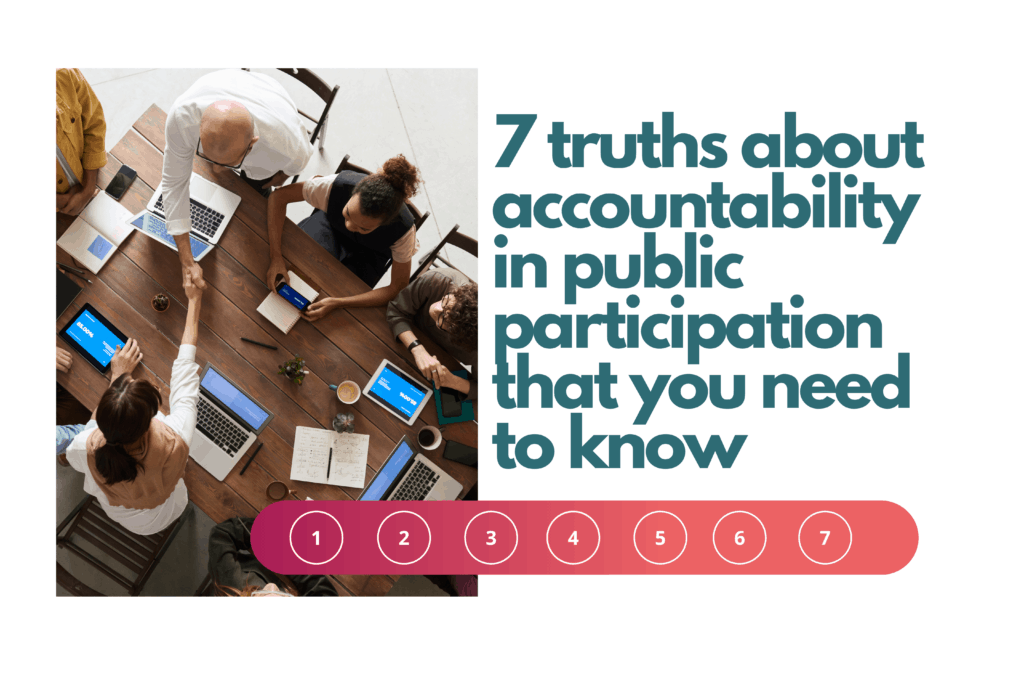7 truths about accountability in public participation that you need to know

Interested in accountability and public participation? They’re two big, important concepts that go hand in hand – it’s tricky to properly do one without the other.
Let’s lay the foundations with some definitions…
Public participation
Public participation – also referred to as citizen participation or public involvement – is a type of stakeholder engagement that works towards an environment where people (members of the public) who are interested in a decision or affected by it are involved in the process.
True public participation facilitates involvement so that the public can genuinely influence decisions and outcomes that might affect them.
And while public participation is often a political practice or principle, this practice extends to organizations, too (especially large ones).
Accountability
Accountable relationships include two key components – they must be answerable and enforceable. In public participation, this means members of the public have a right to be heard and get a response back, plus ensure suitable action is taken.
Accountability goes nicely with public participation because it ensures that participation has a purpose – keeping governments and organizations accountable. And public participation – seeking input from the public – is often necessary to ensure groups stay accountable, deliver on their promises, make the best decisions and do good.
But it’s not always simple or straightforward to achieve accountability through public participation. Here are 7 truths and realities you can expect to come across when you start putting it into practice…
A lot of organizations aren’t comfortable with true public participation
Public participation sounds great in principle, but for many organizations, it represents a burden and added cost. Not to mention sharing information they may not feel comfortable in the public domain, accessible to all people/citizens, not just the company’s insiders.
Governments and businesses must be able to justify their actions – theoretically, keeping them accountable means better and fairer decisions. In many ways, they’re already held accountable under the law. And with democracy, there’s a degree of public accountability since bad governments (usually) don’t get re-elected.
But there’s still a lot of resistance to public participation and accountability for all of the above reasons. True public participation and accountability means handing over a degree of control to the public – something that not many organizations find easy to do.
But whether they like it or not, organizations and governments need to accept that our world is moving towards increased transparency and openness. That said…
There can be too much of a good thing
Public participation and accountability is generally a beneficial and essential part of governance. But too much of it can negatively impact on performance – the ability to get stuff done.
This is because if organizations and governments are afraid to make a move or break a rule, they’ll make decisions at a slower pace. In an age where everything seems to be speeding up, slower decision-making could hold back entire organizations and governments from moving forward and making an impact.
One study found that in situations where resources are scarce accountability negatively impacted on outcomes because people were too worried about what people would think of their actions, rather than focusing on the best, most logical way to use the resources.
Plus, transparency can be good, but if someone goes looking for an error or a hole to support their case, they’ll find it, whether it’s relevant to the decision or not.
So it’s important to strike a balance with the right amount of accountability in your public participation processes as an organization or government that wants to do the right thing, while continuing to move forward.
It requires real action
Let’s dispel some myths and talk about what public participation isn’t:
- It’s not a PR stunt to try to keep people happy or make governments and organizations look good.
- It’s not there to help you shy away from controversy or manage and avoid conflicts.
- It’s not meant to influence the public in line with your organization’s goals.
- It’s not there to address the impacts of a project or initiative
Proper public participation and accountability require real action with real impact. Public participation is:
- Shaping policies, projects, and initiatives
- Based on real public involvement and feedback
- Meant to give the public influence and control
It’s not enough to say you welcome public participation and accountability – your actions must match your words. That means:
- Agreeing on a shared vision and common goals
- Providing transparency around information and relationships
- Sharing resources
- Ensuring easy access to information
- Agreeing on clearly defined roles and responsibilities
- Involving all stakeholders
- Accepting responsibility to represent and actively seek out all interests
- Empowering the public so they can identify issues, suggest solutions, make decisions, take actions, allocate funds, negotiate, etc.
- Creating a system to manage and resolve conflicts
- Developing a process to monitor whether you’ve stuck to agreements
- Developing a way to track whether the public are aware of the information, have considered it, are learning from it and are participating
- Setting up clear processes for decision-making
- Providing spaces for discussion and negotiation
- Ensuring it’s sustainable
- Making sure your resources are being used effectively and to full potential
As you can see, public participation can be an extremely involved process – and without real action and accountability, you’re not doing it right.
The public won’t participate unless they see they’ll have an impact
Flowing on from our last point – you can’t expect participation from communities if they don’t believe it will have an effect or that your organization will be accountable for changes.
After all, why should people participate if it won’t get them closer to their goals or be meaningful for them?
Public participation means ensuring people are heard, respected and their input has a genuine influence on decision-making and outcomes. Governments and organizations need to listen and respond to feedback and participation. And they need to be held accountable to follow through on discussions and input from the public.
If you want increased participation, you’ll need to demonstrate its benefits, how you’ll incorporate any feedback or comments you receive, and how you’ll be held accountable.
Accountability can mean better outcomes for all
When decisions are made by the powerful few (even though they affect the wider public) they might not have the best outcomes for everyone.
Accountability helps even out the power and ensure a wider group of people (especially those who are marginalized or discriminated against) are represented and have the opportunity to participate and influence decisions that affect them. And that’s a very good thing.
We’ve already touched on this, but it’s worth another mention. Increasing accountability reflects how society is moving both in politics and workplaces – from hierarchical, top-down decision-making to a model that includes a range of stakeholders who have a voice and the ability to influence outcomes.
Plus, accountability is an essential part of democracy – and it requires public participation. Without the public participating, who’s going to hold government officials or politicians accountable for what they have or haven’t done?
And a more accountable government with a more actively participating public will usually lead to more trust. Greater transparency, more promises fulfilled, better use of resources – these are all beneficial common side effects of public participation and accountability.
Participants may not match the public
We’ve already touched on this one as well, but it’s worth exploring further.
Inclusiveness and diversity matters with public participation, but it can be tricky to get the right balance of public representatives. As much as possible, it’s your responsibility to ensure your participants match the public and people who are interested in and affected by your organization, project and decisions.
So get to know your public and ask yourself:
- What demographics am I dealing with?
- What marginalized groups do I need represented?
- How can I reach those harder-to-reach groups?
- How can I encourage their participation?
- How can I represent your information so it’s accessible and easy to understand?
- Are our events and meetings accessible to people with disabilities?
- Are they located in areas where marginalized groups can comfortably participate?
- Can I incorporate other formats to maximize participation from different groups?
You need public participation processes to track accountability
It’s easy enough to say you’re increasing public participation, but to be accountable, you need to prove it with real data.
Data like:
- Public expenditure tracking surveys
- Budget monitoring
- Score cards
- Social audits
- Community surveys
- Citizen report cards
These can all be used to track and develop accountable relationships between the public and organizations or governments.
Finding the right public participation processes can take some time and creative thinking. There’s no one size fits all. But a good place to start is to create a stakeholder management plan that incorporates principles public participation. Use stakeholder management software to stay on top of your tasks and actions, and track key relationships, emerging issues, communication, and more.
Ready to get started? Please contact us if you have any questions about how to set up your public participation processes in our software.



































